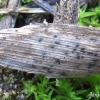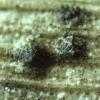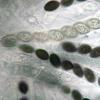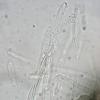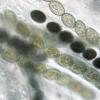
02-01-2015 20:50
Hola a todos: Ascomas emergentes, incrustados en s

28-12-2014 13:04
 Rubén Martínez-Gil
Rubén Martínez-Gil
Hola a todos. Subo unas fotos de un asco que enco

31-12-2014 00:05
 Rubén Martínez-Gil
Rubén Martínez-Gil
Hola a todos. Subo unas fotos de un Ascobolus que

29-12-2014 21:06
Hola a todos. Os presento esta posible Calycellina

29-12-2014 18:21
Paul CannonHello all, very best wishes for an exciting and fu
En hoja de Foeniculum vulgare
Javier Ormad,
02-01-2015 20:50
Ascomas emergentes, incrustados en sustrato, negros, sin llegar a evidenciar con claridad ostiolo, de menos de 1 mm de ø.
Ascas claviformes, 8 esporas, uniseriadas (en varias posiciones), croziers+, IKI+ muy marcado, de 90-110 x 11-12 µ. Esporas elípticas, lisas, en varios estadios, inicialmente hialinas con múltiples inclusiones vacuolares en su interior, al madurar adquieren tonalidad marrón oscuro, con el mismo contenido de 12-13 x 7-8 micras. Parafisis filiformes, septadas, ramificadas, de unas 2 µ. de grosor.
En hoja basal desecada de Foeniculum vulgare, en zona de duna fija en Valencia (costa mediterránea). 31.12.2014.
¿Diaporthe? ¿Alguna idea?
Gracias
Javier Ormad
Chris Yeates,
02-01-2015 21:17

Re : En hoja de Foeniculum vulgare
Hola Javier
certainly not Diaporthe which has hyaline, one-septate spores and very different asci.
Xylariaceae? If the spores were narrower I would be wondering about an Anthostomella: is there a clypeus? Any sign of a germ pore, or germ slit on the spores? It is hard to see from here.
best wishes
Chris
certainly not Diaporthe which has hyaline, one-septate spores and very different asci.
Xylariaceae? If the spores were narrower I would be wondering about an Anthostomella: is there a clypeus? Any sign of a germ pore, or germ slit on the spores? It is hard to see from here.
best wishes
Chris
Jacques Fournier,
02-01-2015 21:41

Re : En hoja de Foeniculum vulgare
Good evening Javier and Chris,
I agree with Chris it should be Anthostomella and more information about the germ slit and the presence of a sheath around the spores is needed. If the germ slit proves to be straight and as long as the spore, Anthostomella spartii might be considered.
Javier, try to make a thin slide with little material and no dirts, the germ slits should become conspicuous, especially on immature, weakly pigmented spores.
Cheers,
Jacques
I agree with Chris it should be Anthostomella and more information about the germ slit and the presence of a sheath around the spores is needed. If the germ slit proves to be straight and as long as the spore, Anthostomella spartii might be considered.
Javier, try to make a thin slide with little material and no dirts, the germ slits should become conspicuous, especially on immature, weakly pigmented spores.
Cheers,
Jacques
Javier Ormad,
03-01-2015 00:34
Re : En hoja de Foeniculum vulgare
Hola Chris y Jacques.
He hecho otra preparación, pero no he podido sacar mucha más información. Está algo inmadura pues apenas se ve alguna espora fuera del asca; no consigo mucha nitidez, pero no he visto poro germinal y alguna espora me pareció ver hendidura esporal longitudinal.
De todas formas, si que parece género Anthosporella; será cuestión de volver a mirar otros ejemplares pueda recolectar.
Saludos
He hecho otra preparación, pero no he podido sacar mucha más información. Está algo inmadura pues apenas se ve alguna espora fuera del asca; no consigo mucha nitidez, pero no he visto poro germinal y alguna espora me pareció ver hendidura esporal longitudinal.
De todas formas, si que parece género Anthosporella; será cuestión de volver a mirar otros ejemplares pueda recolectar.
Saludos


